
Some brides and grooms wear kimonos in traditional Japanese weddings, but there are several types of wedding kimonos available. The bride and groom's family, and wedding guests may also wear kimonos. This time, we will introduce the types of wedding kimonos that differ depending on the status and position.
Bride's Wedding Kimono: 3 types available

Generally, there are three types of kimonos that women wear at weddings. These are Shiromuku (白無垢 stain-less white) woven in solid white, gorgeous and colourful Iro-Uchikake (色打掛 coloured sash-less robe), and Furisode (振袖 hanging sleeve) worn by unmarried women.
Shiromuku (白無垢), A White Wedding Kimono

Shiromuku woven in solid white is the most prestigious formal attire that has been worn at weddings since ancient times. It features a uniform white outfit that covers everything from the Wataboshi (綿帽子 cotton hat) or Tsunokakushi (角隠し horn-hiding hat) worn on the head, to the embroidery of kimonos, and even small decoration items. This is a wedding garment that is mainly worn at weddings, which means that you can get rid of evil and attend a sacred wedding ceremony.
For those who wants to know more about White Kimono, check out this article
Iro-Uchikake (色打掛), A Coloured Wedding Kimono

The vivid iro-uchikake is the standard wedding clothes that is almost as popular as shiromuku. The fabric has gorgeous patterns drawn with embroidery and dyeing, which makes it enjoyable to choose colors and patterns. Other than white, the traditional iro-uchikake are made of red, green, black, etc., and the auspicious patterns such as cranes, turtles, phoenixes, and Suehiro (末広 unfolded fan) are embroidered with gold and silver threads. Recently, pastel-colored color hits have also made their appearances, and are gaining popularity from young people.
Furisode (振袖), A Kimono for Celebration
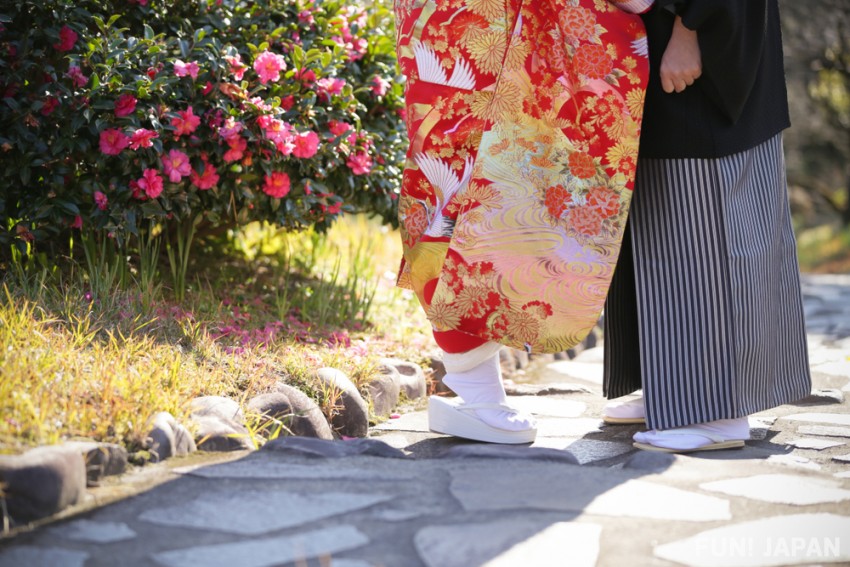
Furisode is the first go-to dress for unmarried women, and it is sometimes worn at weddings because the wedding is the last opportunity to wear furisode (before becoming a married woman). Furisode is lighter and easier to move than shiromuku or iro-uchikake, so some people may choose to do the Iro-naoshi (色直し change the colour, referring to changing the clothes) at the wedding reception. Additionally, the Hiki-furisode (引き振袖 dragging sleeve), which has longer sleeve than normal furisode, is also preferred for wedding ceremony.
Groom's Wedding Kimono
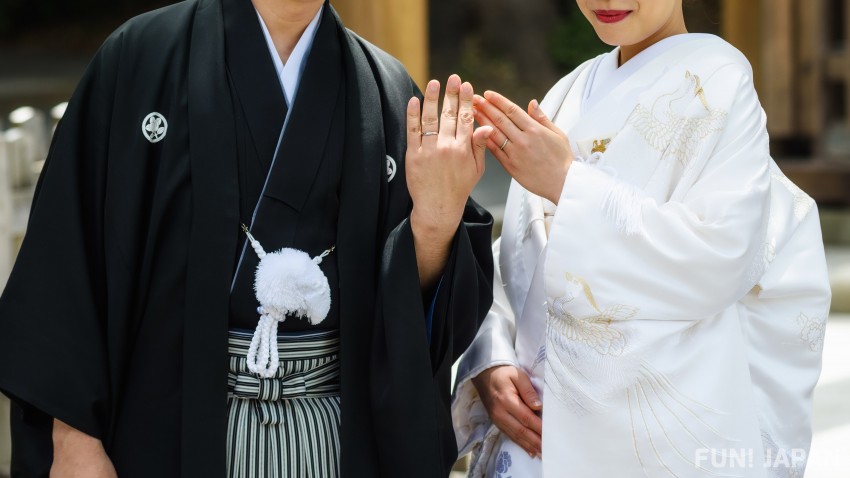
The only kimono that men wear at weddings is a Montsuki Haori Hakama (紋付き羽織袴 kimono with haori and hakama, decorated with family crests). This is a combination of haori and hakama with family crests.
What is the formal color?
There are white, navy blue, gray, etc., but the one with a high formality is the black montsuki haori hakama. Especially, the black one with five family crests is the most formal and official.
What is Montsuki?
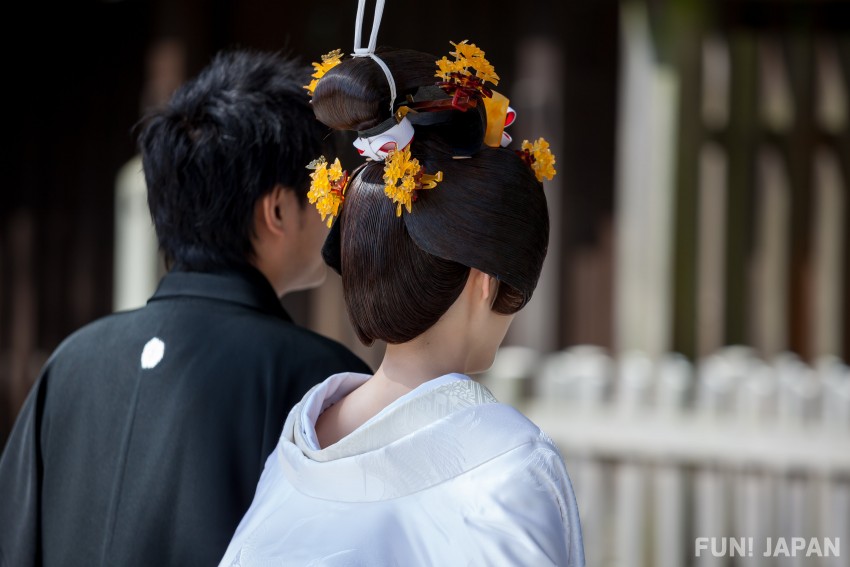
The "Mon" in "Montsuki" refers to a family crest (家紋 / Kamon). A family crest is a mark of each house. And the black haori hakama with five family crests is a traditional outfit that was stipulated as "formal dress for men" by the law issued in the Meiji era. The family crests are placed in the center of Haori's back, both sleeves, and both chests.
By the way, the number of crests printed on a man's kimono is either 5, 3, or 1. The "three crests" (三つ紋 Mitsu-mon) have crests only in the center of the back and on the back sleeves, for total of three; with none on both chests. "One crest" has a crest only in the center of the back.
In all cases, the size of the crest is the same, about 4 cm for men and about 2 cm for kimono for women. If the position of the crest is not correct, it cannot be used in any basically formal place.
Wedding Kimono for the family and relatives of bride and groom

In general, guests and relatives have some kimonos that they should be wearing and those that should not. First, we would like to introduce the wedding kimono of family members and relatives attending a wedding.
Wedding Kimono: female family and relatives
Marrying couple's family members, relatives, and Nakoudo (仲人 matchmakers, plays similar role as maid of honour, bridesmaid in wedding) wear “Kuro Tomesode” (黒留袖 black cut sleeve). Black tomesode is the first go-to dress of a married woman; a black kimono with family crest. Unmarried family members and relatives wear "Iro Tomesode" (色留袖 coloured cut sleeve), "Homongi" (訪問着 visiting clothes), and "furisode."
By the way, the nakoudo or matchmaker refers to the person who officially mediates the bride and groom, and is unique to Japan. Being a married couple is a traditional convention.
Wedding Kimono: male family and relatives
Male's kimono do not have difference between being married or unmarried. The first go-to dress for men's kimono is the "Montsuki Haori Hakama", which is mainly black or gray. Coloured kimono is not worn.
Wedding Guest's Kimono
In this part, we introduce the kimonos of the guest invited to the wedding. This also differs for men and women, and for women it depends on whether they are married or unmarried.
Female Guest's Kimono
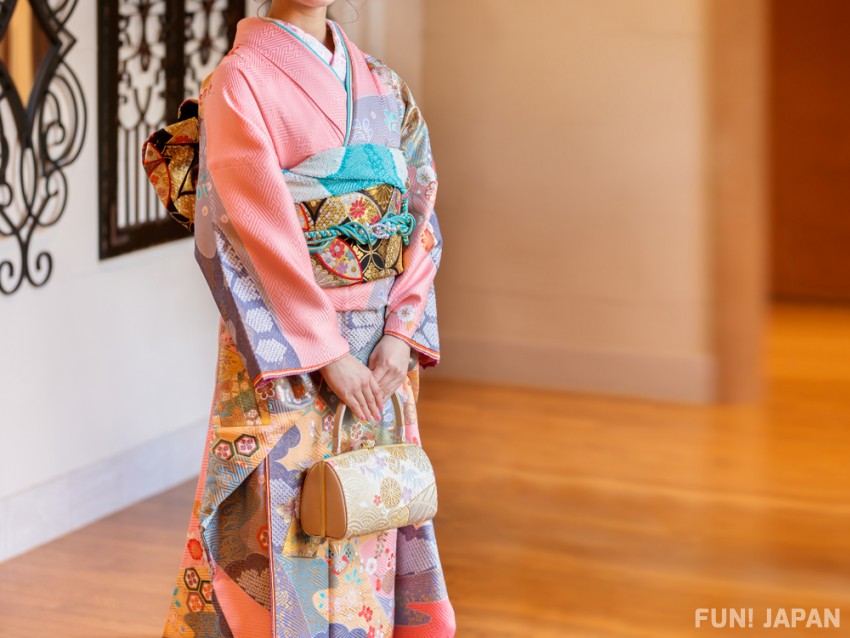
Married women participating as guests wear coloured tomesode. Unmarried female guests wear furisode.
You can wear homongi at weddings regardless of whether you are married or not. Among them, a gorgeous pattern-design and a kimono or obi that is embroidered with gold and silver threads are worn to create a festive, celebrating mood.
Male Guest's Kimono
Males do not have difference between being married or unmarried. It is common to wear "Iro-Montsuki" (色紋付 coloured kimono with family crests) which comes in colours other than black. Haori is similar to Western-style jacket for suit, so always wear haori at weddings.
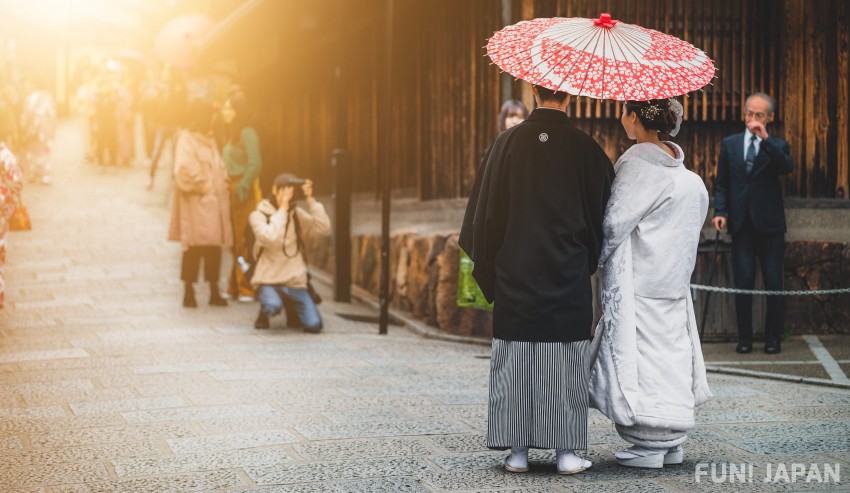
How do you like it so far? Do you want to try the Japanese wedding style just for taking a photo?

Comments